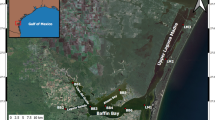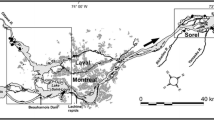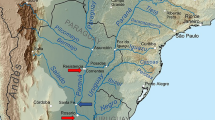Abstract
Water, suspended particulate materials (SPM), and biota were sampled between June 14 and 22, 1992 at forty-five mid-channel sites along a downstream gradient in the lower 350 km of the Columbia River drainage, at four mid-channel sites in the lower 27 km of the Willamette drainage and at the mouths of nine smaller tributaries to the Columbia. Water samples were analyzed for nutrient (ammonium, nitrate, phosphate, silicate), dissolved organic carbon (DOC) and SPM concentrations, bacterial cell density and activity, and zooplankton composition and density. The SPM samples were analyzed for particulate organic carbon (POC), plant pigment (chlorophyll and pheopigment) and major metal (Al, Mn, Ti, V) content as well as stable isotopic (\(\delta ^1 \)3C) composition of the POC. Willamette waters displayed significantly higher nutrient and DOC concentrations than those in the mainstem Columbia or any of the smaller tributaries. Elevated nutrient and DOC concentrations are attributed to runoff from the extensive agricultural lands found throughout the Willamette Valley. Regardless of collection site, total Al content of all riverborne particles was high (5.8 ± 0.5% by weight), indicating total SPM mass was predominantly (∼ 70±) detrital mineral. Nonetheless, the majority of riverborne organic matter was not allochthonous but rather derived from healthy phytoplankton as indicated by high chlorophyll a to POC (Chl:POC) values. Chlorophyll a concentration increased by almost 100% downstream in the mainstem Columbia between Bonneville Dam and the estuary. This apparent increase in phytoplankton biomass was not accompanied by a parallel decrease in any nutrient concentration probably because non-point source additions occurred all along the drainage and compensated for nutrient loss due to phytoplankton growth. Despite nutrient concentrations near eutrophic levels, phytoplankton biomass in the Willamette was significantly lower than that in the mainstem Columbia. This particular contrast between the Willamette and the mainstem Columbia is likely due to light limitation imposed on the phytoplankton by specific differences in the mixing dynamics of the two flow regimes. POC in Willamette waters displayed a 50% reduced chlorophyll content and 2–2.5% 13C-depletion relative to that present in waters from the mainstem Columbia. These compositional dissimilarities may simply reflect physiological difference between the diatom communities that comprised the bulk of phytoplankton in these two systems at the time of sampling. Alternatively, they may be caused by greater contribution of POC from non-phytoplankton sources in the Willamette. An argument is advanced suggesting that methanotrophy has contributed up to 5% of the POC that was measured in the Willamette River at the time of our study.
Similar content being viewed by others
References
de Angelis, M. A. & M. D. Lilley, 1986. Methane in surface waters of Oregon estuaries and rivers. Limnol. Oceanogr. 32: 716–722.
Bell, R. T., 1993. Estimating production of heterotrophic bacterioplankton via incorporation of tritiated thymidine. In Kemp, P. F., B. F. Sherr, E. B. Sherr & J. J. Cole (eds), Handbook of Methods in Aquatic Microbial Ecology. Lewis Publishers, Boca Raton: 495–503.
Berner, E. K. & R. A. Berner, 1996. Global Environment: Water, Air and Geochemical Cycles. Prentice Hall: 376 pp.
Bristow, M. P. F., D. H. Bundy, C. M. Edmonds, P. E. Ponto, B. E. Frey & L. F. Small, 1985. Airborne laser fluorosensor survey of the Columbia and Snake rivers: simultaneous measurements of chlorophyll, dissolved organics and optical attenuation. Int. J. Remote Sensing 6: 1707–1734.
ChinLeo, G. & R. Benner, 1992. Enhanced bacterioplankton production and respiration at intermediate salinities in the Mississippi River plume. Mar. Ecol. Prog. Ser. 87: 87–103.
Cicerone, R. J. & R. S. Oremland, 1988. Biogeochemical aspects of atmospheric methane. Global Biogeochem. Cycles 2: 299–327.
Collier, R., 1991. Analysis of particulate matter collected by sediment traps and from sediment corres. In Hurd, D. C. & D. W. Spencer (eds), Marine Particles: Analysis and Characterization, Geophysical Monograph 63. American Geophysical Union: 235–242.
Conover, R. J. & R. Durvasula, 1986. Probable loss of chlorophyll-derived pigments during passage through the gut of zooplankton, and some of the consequences. Limnol. Oceanogr. 31: 878–887.
Craddock, D. R., T. H. Blahm & W. D. Parente, 1976. Occurrence and utilization of zooplankton by juvenile chinook salmon in the lower Columbia River. Trans. Am. Fish. Soc. 1: 72–76.
Crump, B. C., J. A. Baross & C. A. Simenstad, 1997. Dominance of particle-attached bacteria in the Columbia River estuary, USA. Aquat. Microbial. Ecol., 14: 7–18.
Dahm, C. N., S. V. Gregory & P. K. Park, 1981. Organic carbon transport in the Columbia River. Estuar. Coast. Shelf Sci. 13: 645–658.
Dietrich, W., 1995. Northwest Passage: The Great Columbia River. Simon & Schuster: New York: 448 pp.
Eganhouse, R. P.& I. R. Kaplan, 1988. Depositional history of recent sediments from San Pedro Shelf, California: reconstruction using elemental abundance, isotopic composition and molecular markers. Mar. Chem. 24: 163–191.
Evergreen Pacific Publishing, 1995. River Cruising Atlas: Columbia, Snake, Willamette, Accord Communications Ltd: Seattle, WA.
Fuhrman, J. & F. Azam, 1982. Thymidine incorporation as a measure of heterotrophic bacterioplankton production in marine surface waters: evaluation and field results. Mar. Biol. 66: 109.
Fuhrer, G. J., D. Q. Tanner, J. L. Morace, S. W. McKenzie & K. A. Skach, 1996. Water Quality of the Lower Columbia River Basin: Analysis of Current and Historical Water Quality Data through 1994. U.S. Geological Survey Water-Resources Investigations Report 95-4294, Portland Oregon, 157 pp.
Gaggi, C., G. Sbrilli, A. M. Hasab El Naby, M. Bucci, M. Duccini & E. Bacci, 1995. Toxicity and hazard ranking of striazine herbicides using Microtox, two green algal species and a marine crustacean. Envir. Toxicol. Chem. 14: 1065–1069.
Griffith, P., F.-K. Shiah, K. Gloersen, H.W. Ducklow & M. Fletcher, 1994. Activity and distribution of attached bacteria in Chesapeake Bay. Mar. Ecol. Prog. Ser. 108: 1–10.
Haertel, K. & C. Osterberg, 1967. Ecology of zooplankton, benthos and fishes in the Columbia River estuary. Ecology 48: 459–472.
Haertel, L., C. Osterberg, J. Curl Jr. & P. K. Park, 1969. Nutrient and plankton ecology of the Columbia River estuary. Ecology 50: 962–978.
Harris, G.P., 1986. Phytoplankton Ecology: Structure, Function and Fluctuation. University Press: Cambridge, 384 pp.
Hayes, J. M., 1983. Practice and principles of isotopic measurements in organic geochemistry. In Meinshein, W. G. (ed.), Organic Geochemistry of Contemporaneous and Ancient Sediments: 5–1, 5-31.
Hersh, C. M. & W. G. Crumpton, 1989. Atrazine tolerance of algae isolated from two agricultural streams. Envir. Toxicol. Chem. 8: 327–332.
Hobbie, J. E., R. J. Daley & S. Jasper, 1977. Use of nuclepore filters for counting bacteria by fluorescence microscopy. Appl. Envir. Microbiol. 33: 1225.
Jackson, P. L. & A. J. Kimmerling, 1993. Atlas of the Pacific Northwest. 8th Edition. OSU Press, 152 pp.
Laws, E. A., B. N. Popp, R. R. Bidigare, M. C. Kennicutt & S. A. Macko, 1995. Dependence of phytoplankton carbon isotopic composition on growth rate and [CO2]aq: Theoretical considerations and experimental results. Geochim. Cosmochim. Acta 59: 1131–1138.
van der Leeden, F., F. L. Troise & D. K. Todd, 1990. The Water Encyclopedia, 2nd edn., Lewis Publishers, 808 pp.
Lilley, M. D., M. A. de Angelis & E. J. Olson, 1996. Methane concentrations and estimated fluxes from Pacific northwest rivers. In Adams, D. D., S. P. Seitzinger & P. M. Crill (eds), Cycling of Reduced Gases in the Hydrosphere, E. Schweizerbart'sche Verlagbuchhandlung, Stuttgart: 187–196.
Porter, K. G. & Y. S. Feig, 1980. The use of DAPI for identifying and counting aquatic microflora. Limnol. Oceanogr. 25: 943–948.
Prahl, F.G., J.R. Ertel, M. A. Goni, M. A. Sparrow & B. Eversmeyer, 1994. Terrestrial organic carbon contributions to sediments on the Washingtonmargin. Geochim. Cosmochim.Acta 58: 3035–3048.
Prahl, F. G., J.M. Hayes & T.M. Xie, 1992. Diploptene: an indicator of terrigenous organic carbon in Washington coastal sediments. Limnol. Oceanogr. 37: 1290–1300.
Prahl, F. G., L. F. Small & B. Eversmeyer, 1997. Biogeochemical characterization of suspended particulate matter in the Columbia River estuary. Mar. Ecol. Progr. Ser. 160: 173–184.
Rashid, M. A., 1985. Geochemistry of Marine Humic Compounds. SpringerVerlag: New York, 300 pp.
Rickert, D. A., R. R. Petersen, S. W. McKenzie, W. G. Hines & S. A. Wille, 1977. Algal conditions and the potential for future algal problems in the Willamette River, Oregon. Geological Survey Circular 715G, 39 pp.
Riemann, B., P. Simonsen & L. Stensgaard, 1989. The carbon and chlorophyll content of phytoplankton from various nutrient regimes. J. Plankt. Res. 11: 1037–1045.
Rohmer, M., P. Bouvier-Nave & G. Ourrison, 1984. Distribution of hopanoid triterpenes in prokaryotes. J. Gen. Microbiol. 130: 1137–1150.
Servais, P. & J. Garnier, 1993. Contribution of heterotrophic bacterial production to the carbon budget of the River Seine. Microb. Ecol. 25: 19–33.
Servais, P., 1989. Bacterioplanktonic biomass and production in the River Meuse (Belgium). Hydrobiol. 174: 99–110.
Scranton, M. I. & K. McShane, 1991. Methane fluxes in the southern North Sea: the role of European rivers. Cont. Shelf Res. 11: 37–52.
Sherwood, C. R., D. A. Jay, R. B. Harvey, P. Hamilton & C. A. Simenstad, 1990. Historical changes in the Columbia River Estuary. Prog. Oceanog. 25: 299–352.
SickoGoad, L. M., C. L. Schelske & E. F. Stoermer, 1984. Estimation of intracellular carbon and silica content diatoms from natural assemblages using morphometric techniques. Limnol. Oceanogr. 29: 1170–1178.
Simenstad, C. A. & J. R. Cordell, 1985. Structural dynamics of epibenthic zooplankton in the Columbia River Delta. Verh. int. Ver. Limnol. 22: 2173–2182.
Simenstad, C. A., D. J. Reed, D. A. Jay, J. A. Baross, F. G. Prahl & L. F. Small, 1994. Land-Margin Ecosystem Research in the Columbia River estuary: an interdisciplinary approach to investigating couplings between hydrological, geochemical and ecological processes with estuarine turbidity maxima. In Dyer, K. R. & R. J. Orth (eds), Changes in Fluxes in Estuaries: Implications from Science to Management. Olsen & Olsen: Fredensborg: 437–444.
Simenstad, C. A., L. F. Small, C. D. McIntire, D. A. Jay & C. Sherwood, 1990. Columbia River Estuary studies: an introduction to the estuary, a brief history, and prior studies. Prog. Oceanogr. 25: 1–13.
Strickland, J. D. H. & T. R. Parsons, 1972. A Practical Handbook of Seawater Analysis. Bulletin 167 (2nd edn). Fisheries Research Board of Canada, 310 pp.
Sullivan, B., 1997. Annual Cycles of Organic Matter and Phytoplankton Attributes in the Columbia and Willamette Rivers, with Reference to the Columbia River Estuary. Masters Thesis, Oregon State University, 114 pp.
Summons, R. E., L. L. Jahnke & Z. Roksandic, 1994. Carbon isotopic fractionation in lipids from methanotrophic bacteria: relevance for interpretation of the geochemical record of biomarkers. Geochim. Cosmochim. Acta 58: 2853–2863.
Taylor, S. R., 1964. Abundance of chemical elements in the continental crust: a new table. Geochim. Cosmochim. Acta 28: 1273–1285.
Tetra Tech, Inc, 1992. Willamette River Basin Water Quality Study, Final Report (TC898311) to Oregon Department of Environmental Quality, 56 pp.
Velji, M. I. & L. J. Albright, 1986. Microscopic enumeration of attached marine bacteria of seawater, marine sediment, fecal matter, and kelp blade samples following pyrophosphate and ultrasound treatments. Can. J. Microbiol. 32: 121–126.
Zar, J. H., 1983. Biostatistical Analysis. Prentice Hall, Englewood Cliffs, New Jersey.
Zweifel, U. L., J. Wikner, A. Hagstrom, E. Lundberg & B. Norrman, 1995. Dynamics of dissolved carbon in a coastal ecosystem. Limnol. Oceanogr. 40: 299–305.
Author information
Authors and Affiliations
Rights and permissions
About this article
Cite this article
Prahl, F.G., Small, L.F., Sullivan, B.A. et al. Biogeochemical gradients in the lower Columbia River. Hydrobiologia 361, 37–52 (1997). https://doi.org/10.1023/A:1003129124747
Issue Date:
DOI: https://doi.org/10.1023/A:1003129124747




